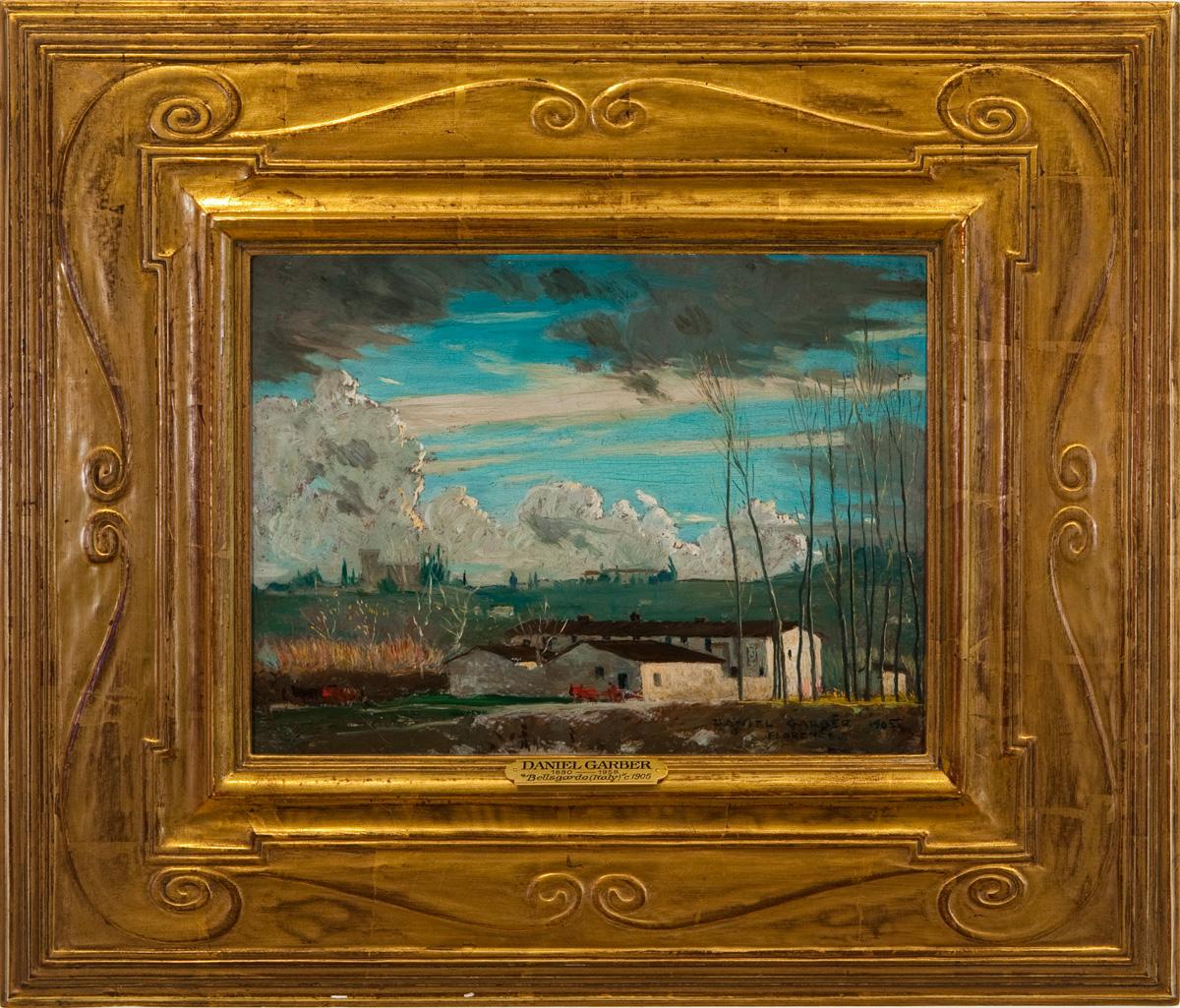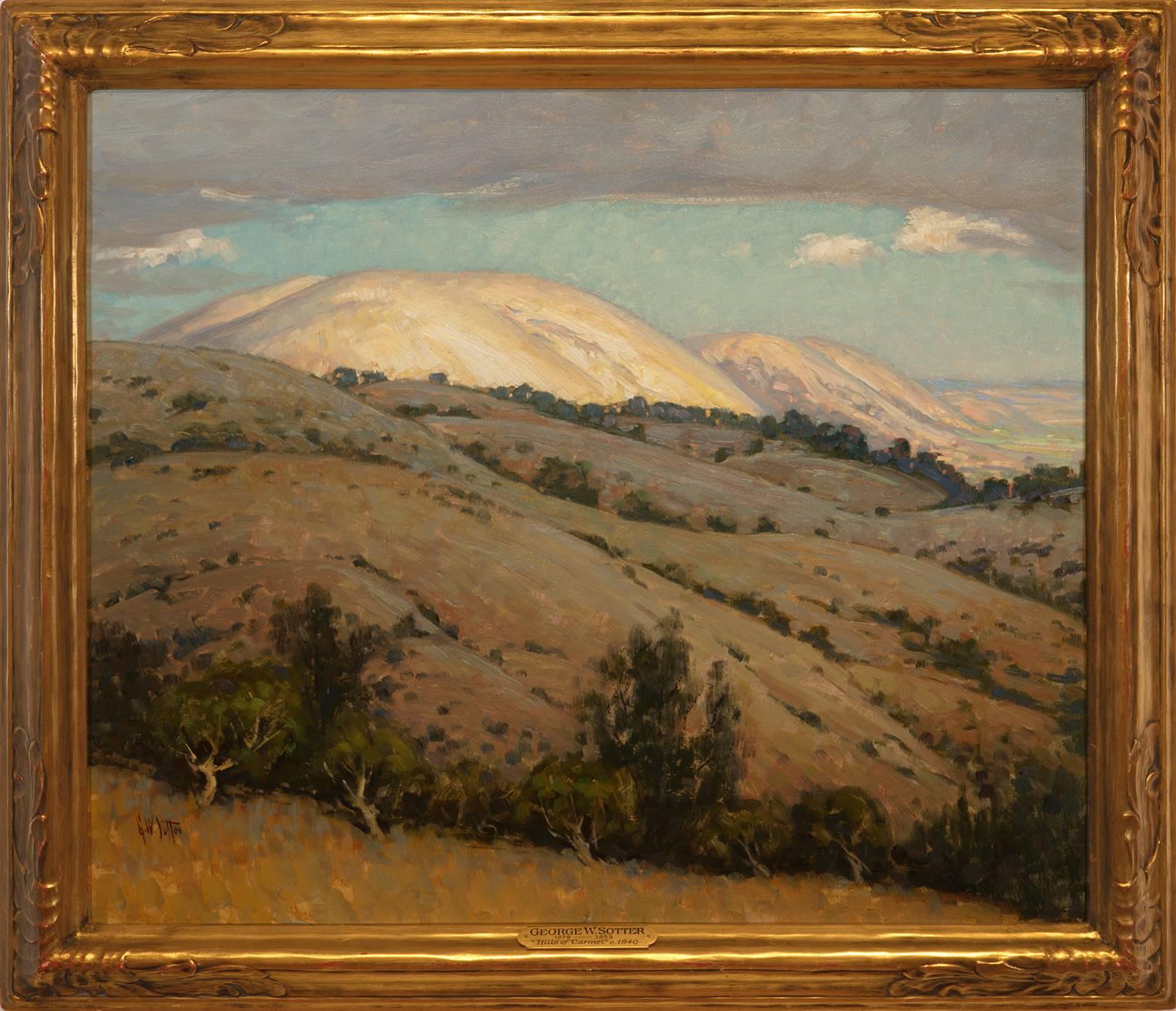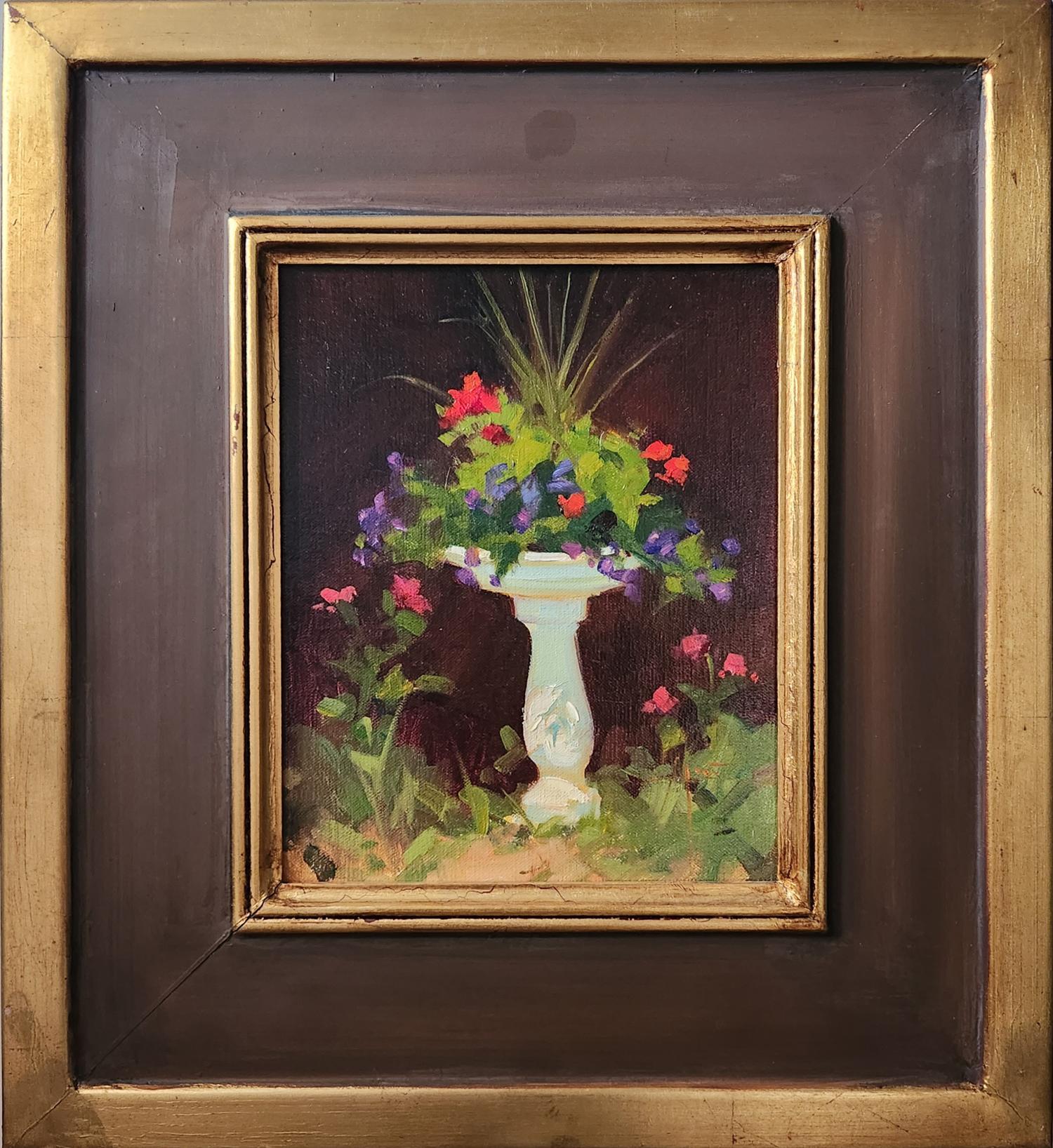William Merritt PostAutumn Landscape
About the Item
- Creator:William Merritt Post (1856 - 1935, American)
- Dimensions:Height: 10 in (25.4 cm)Width: 14 in (35.56 cm)Depth: 2 in (5.08 cm)
- Medium:
- Movement & Style:
- Period:
- Condition:
- Gallery Location:Saratoga Springs, NY
- Reference Number:1stDibs: LU170212937922
William Merritt Post
William Merritt Post was born in 1856 in Brooklyn, New York. As the son of a commodities merchant, his parents separated after 16 years of marriage and four children. Post developed his eye for composition, his technical knowledge of the craft of painting and his deft draftsmanship in the artistic community of New York. At the age of 24, he began taking drawing lessons from Samuel Frost Johnson and by 1880, Post had already begun painting Hudson River pictures on academic boards and signing them W. Post. By 1881–82, he moved on to the Art Students League, where he worked with J. Carroll Beckwith. Paintings during this phase were signed W. M. Post and by the age of 28 in 1884, Post had launched his career as a landscapist. That same year, the National Academy of Design accepted for its autumn exhibition one of his paintings signed W. Merritt Post. This remained his signature for the rest of his professional life. It was in these years that he became greatly influenced by the landscape painter, Hugh Bolton Jones. Both of them were attracted to tightly focused landscape scenes, particularly streams amid trees and meadows, and their primary goal was to capture light at different times of the day and in different seasons. This predilection, in turn, drove both artists to excursions outside of New York into the countryside of the marsh towns in New Jersey and on Long Island, especially in the marsh areas of Milburn, South Orange and Nutley. By the 1890s, Post perfected the country stream motif and the evident profitability of these paintings so he became financially independent of his father, being this of great significance for the artist that kept the interpretation of this theme for the rest of his life. Post exhibited continually at the National Academy of Design, the Philadelphia Academy of Fine Arts as well as the Boston Museum of Fine Arts. He also exhibited in Buffalo, Chicago, St. Louis and the Corcoran Gallery of Art in Washington DC, receiving many awards. As an American artist that was making a living from his art, in 1906 at the age of 49, Post married his wife, Katherine Van Nest, who was 36 at that time. The Post’s summered in Bethlehem, Connecticut around 1908 becoming noted for his landscape paintings done there. Also, he was an active member of the two watercolor clubs that had been established in New York City. Post was later elected an associate member of the National Academy of Design in 1910. In 1912, they purchased a farm in West Morris (Bantam) 15 miles northwest of Waterbury. With the help of New York architects, the Posts completely remodeled the place adding a studio addition in the process. The Bantam River ran westerly at the back of the property. After settling in his West Morris studio, Post began painting Plein-air landscapes, and traveled throughout the northeast, collecting landscape motifs in his sketchbooks. He became fascinated with country streams and reflections on water, and concentrated on these themes all of his professional life, showing a steady exploration of this country stream theme. Remaining committed to tonalist hues and the rich greens that also appealed to his mentor, Hugh Bolton Jones. Post moved back with his wife to Manhattan at the age of 70 to be close to their daughter. About 1930, Post's started to offer two paintings at the National Academy of Design annual exhibitions, and this was later reduced to one painting per year. Post died in 1935 in New York City at the age of 78. The contents of his studio in West Morris were auctioned off in 1937, and the estate holder donated many items to the Mattatuck Museum, including drawings, sketchbooks, small oil paintings, documents, and artists' materials.
- ShippingRetrieving quote...Ships From: Saratoga Springs, NY
- Return PolicyA return for this item may be initiated within 3 days of delivery.
- Gramacy Army Plaza Brooklyn NYBy Johann Berthelsen, 1883-1972Located in Saratoga Springs, NYSigned lower right. Following his graduation, he toured the United States and Canada as lead baritone for the Grand Opera Company, after which he taught voice - first as his alma matter...Category
Mid-20th Century American Impressionist Landscape Paintings
MaterialsOil, Board
- The Red House, Cornwall, ConnecticutBy Charles Warren EatonLocated in Saratoga Springs, NYSigned lower left. Born in Albany, New York, Charles Eaton became a Tonalist landscape painter much influenced by George Inness. His intimate, moody landscapes were known for subdued golden-brown hues and muted tonal harmonies, and the subject was often the landscape in late autumn, evening time, or winter. These paintings were groundbreaking because they were relatively small in scale and intimate countryside views, which was a departure from the generally popular panoramic, romanticized views of Hudson River School painters. In 1879, he enrolled at the National Academy of Design in New York City and then studied figure painting at the Art Students League with J. Carroll Beckwith. He became a close associate with Leonard Ochtman and Ben Foster...Category
Mid-20th Century American Impressionist Landscape Paintings
MaterialsOil, Canvas
- New York HarborBy Guy WigginsLocated in Saratoga Springs, NYSigned lower right. Guy Carleton Wiggins adopted the bright palette and lively brushwork of the impressionist movement, and is best known for his New York City snow scenes...Category
Mid-20th Century American Impressionist Landscape Paintings
MaterialsOil, Canvas
- Wall Street New YorkBy Gail Sherman CorbettLocated in Saratoga Springs, NYSigned lower right.Category
Mid-20th Century American Impressionist Figurative Paintings
MaterialsOil, Canvas
- High Bridge, New YorkBy Arthur Clifton GoodwinLocated in Saratoga Springs, NYSigned lower right. Bio: A painter especially known for street and waterfront scenes of Boston, Arthur Clifton Goodwin did work that captured the subtle nuances of light and color, ...Category
Early 20th Century American Impressionist Landscape Paintings
MaterialsOil, Canvas
- Pont Neuf, ParisBy Jules PagesLocated in Saratoga Springs, NYPages, Jules (American 1867 - 1946) “Pont Neuf, Paris” Oil on artist board, Pencil sketches and estate stamp verso Estate Stamp signed 13 ½ x 10 ¼ Inches, 23 ½ x 20 ½ Inches, Framed Provenance: Niece of the artist, Normandy, France About A prominent landscape and marine painter, Jules Eugène Pages...Category
Early 20th Century Impressionist Landscape Paintings
MaterialsBoard, Oil
- Miner Hillard Milling CompanyBy George William SotterLocated in New York, NYSigned lower right: G.W. Sotter; on verso: MINER HILLARD / MILLING Co.Category
Mid-20th Century American Impressionist Landscape Paintings
MaterialsOil, Board
- "Bellosguardo (Florence, Italy)"By Daniel GarberLocated in Lambertville, NJJim’s of Lambertville Fine Art Gallery is proud to present this piece by Daniel Garber (1880 - 1958). One of the two most important and, so far, the most valuable of the New Hope Sc...Category
Early 1900s American Impressionist Landscape Paintings
MaterialsOil, Board
- "Autumn Afternoon in Luxembourg Garden"By Martha WalterLocated in Lambertville, NJJim’s of Lambertville is proud to offer this artwork by: Martha Walter (1875-1976) Born in Philadelphia in 1875, Martha Walter attended Girls’ High School followed by the Pennsylva...Category
Early 20th Century American Impressionist Landscape Paintings
MaterialsOil, Board
- "Hills of Carmel"By George William SotterLocated in Lambertville, NJJim’s of Lambertville is proud to offer this artwork. Signed Lower Right George W. Sotter (1879-1953) George W. Sotter is remembered for painting the scenic towns, farms, mills a...Category
1940s American Impressionist Landscape Paintings
MaterialsBoard, Oil
- "Under the Large Striped Umbrella on a Foggy Day"By Martha WalterLocated in Lambertville, NJJim’s of Lambertville Fine Art Gallery is proud to offer this piece by Martha Walter (1875 - 1976). Born in Philadelphia in 1875, Martha Walter attended Girls’ High School followed by the Pennsylvania Academy of the Fine Arts. It was at the Academy that Walter’s artistic talent was discovered. An admiring instructor by the name of William Merritt Chase took young Martha under his wing, giving her both inspiration and direction. She additionally enrolled with Chase at his summer school in Shinnecock, Long Island and in 1903, was awarded the Cresson Traveling Scholarship by the Pennsylvania Academy. This sent Martha Walter on travels to France, Italy, Spain, and Holland, where she attended the Grand Chaumiere and the Academie Julian in Paris. Afterwards, she established a studio on the Rue De Bagneaux in France with several other American women artists...Category
1910s American Impressionist Landscape Paintings
MaterialsBoard, Oil
- Bird Bath, 10x8" oil on boardBy Lu HaskewLocated in Loveland, COBird Bath by Lu Haskew Oil Painting of backyard garden 10x8" image size 18x16" framed Shipping price includes the custom packing necessary for safe transport of fine art. ABOUT THE...Category
Early 2000s American Impressionist Paintings
MaterialsCanvas, Oil, Board






